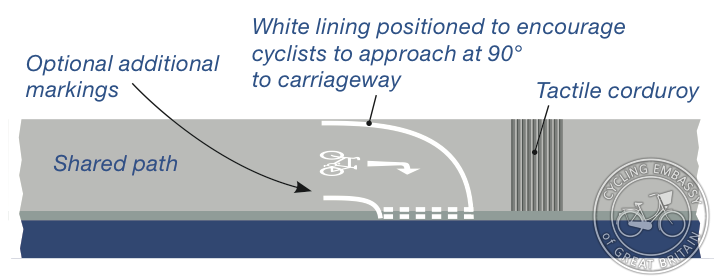Sustrans’ ‘Cycle Design Handbook’
At a time when high standards in cycle infrastructure provision are more important than ever, it is very disappointing that Sustrans have produced a document that, while good in parts, contains a great deal of poor advice, and draws so little on best practice.
 The Sustrans Design Handbook presents many sub-optimal (and even outright dangerous) designs, fails to draw on what is currently possible, and does not discuss what should be possible. The failed ‘dual network’ approach - ‘less confident’ people catered for with different kinds of provision from ‘confident’ cyclists - is still being advocated. This is not ‘best practice’.
The Sustrans Design Handbook presents many sub-optimal (and even outright dangerous) designs, fails to draw on what is currently possible, and does not discuss what should be possible. The failed ‘dual network’ approach - ‘less confident’ people catered for with different kinds of provision from ‘confident’ cyclists - is still being advocated. This is not ‘best practice’.
Instead of focusing clearly on providing the best conditions for cycling, the handbook too readily adopts a compromised approach. For instance, there appears to be an assumption that improvements to public realm are automatically a good cycling environment. But shared space schemes that carry large volumes of motor traffic, without cycle-specific provision (for instance, Poynton, which features in this handbook) should not be included as an example of best practice cycle design. Attractive conditions for cycling require separation from motor traffic, either through genuinely low traffic environments, or through physical separation.
When it comes to cycle-specific measures, there is far too much reliance on advanced stop lines at junctions, particularly with narrow lead-in lanes - a ‘minimum’ of 1.2m width will in practice simply become the default. At the very least we would expect a handbook to highlight how other countries design signal-controlled junctions to minimise or eliminate turning conflicts; this is, however, absent from Sustrans’ guidance.
 Even simple things - like positioning cycle lanes on the inside of parking bays, rather than running them outside of parked vehicles, between car doors that may potentially be opened and passing motor vehicles - are got wrong. Bus lanes are not a suitable environment for cycling, and should not be presented as such. Pinch point conflicts are actually illustrated in this handbook, with a bicycle symbol painted in the road, apparently as an example to follow. Nor is it appropriate to abandon cycle provision at roundabouts, suggesting cyclists ‘mix with traffic’.
Even simple things - like positioning cycle lanes on the inside of parking bays, rather than running them outside of parked vehicles, between car doors that may potentially be opened and passing motor vehicles - are got wrong. Bus lanes are not a suitable environment for cycling, and should not be presented as such. Pinch point conflicts are actually illustrated in this handbook, with a bicycle symbol painted in the road, apparently as an example to follow. Nor is it appropriate to abandon cycle provision at roundabouts, suggesting cyclists ‘mix with traffic’.
The Sustrans' handbook effectively endorses and legitimises much of the substandard provision that many councils are will be tempted to employ, when things get difficult. It appears to be far behind the times, failing to capitalise on the current energy and enthusiasm in cycle campaigning for doing things properly, with other groups working together, to draw on best practice - both here and abroad. It represents a considerable missed opportunity to move on from the poor cycle infrastructure that is all too prevalent on Britain’s streets.
